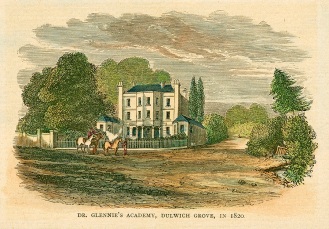Southwark’s historic villages: Dulwich
The London Borough of Southwark, as we know it today, forms a triangle stretching south from the River Thames for just over five miles. The oldest part of Southwark is the area just south of London Bridge known as the Borough. Until the late 18th and early 19th centuries the area south of the Borough was part of the county of Surrey, and was a rural landscape of meadows, farms, market gardens and small villages.
This is the first in a series of posts which will be looking at some of these historic villages.
The area we now know as Dulwich has a long history. We know there were inhabitants as far back as 50 BC to 100AD as Gallo Belgic pottery, donated to the Cuming Museum, was uncovered near Lordship Lane and Highwood.
It took some time for the area to develop its current name, and although there is no mention of Dulwich in the Domesday Book of 1086, there are earlier references to it as far back as 967AD. It was certainly re-settled by 1127 when the King gave the lands to the Priory of the Holy Saviour in Bermondsey (known as Bermondsey Abbey), who remained as the landlords until 1538.
At this time Dulwich was no more than a small hamlet bordering onto fields and, without a church of its own, inhabitants had to travel to Camberwell to worship. Bermondsey Abbey didn’t appear to interfere much in local affairs, beyond collecting its dues and maintaining order. Surviving court records give us a snapshot of life at the time: William Hosegard was accused of running off with the wife, and many possessions, of Richard Rolfe in 1335; and a jury found themselves on the wrong side of the law in 1407 when they were fined for taking dinner before returning a verdict. Petty crime was common, from drunkenness and minor assaults to the crime of milking other peoples’ cows (probably not something we see much of in Dulwich today!).
In 1538 Henry VIII seized control of Bermondsey Abbey and its assets – including Dulwich. The rights to the village were later sold to a London goldsmith by the name of Thomas Calton, for the sum of £609, 18 shilling and 2 pence. His family held the land for almost 70 years, until October 1605, when it was sold to a famous Elizabethan actor, Edward Alleyn, for a princely sum of £4,900.
Alleyn had a major impact on the way Dulwich was run for many years. Most famously he built a college to help educate 12 poor children and make provision for 12 elderly people. Dulwich College is now world famous, with scholars such as Sir Ernest Shackleton, Sir P G Wodehouse and Raymond Chandler.
Dulwich Village still retains much of its rural character due to the protection of the College. Alleyn gave the freehold of his lands and the Dulwich manorial rights to the College, who opposed the over development of the area.
In 1739 a spa was discovered which soon became popular with the visitors. Its site in Dulwich Grove later became Dr Glennie’s Academy, where Lord Byron was educated for two years. At this point Dulwich was still a small, rural development with few links to the outside world – as late as 1792 there was just one public road in Dulwich, which went to Sydenham. The public opening of the Picture Gallery, in 1817 helped to raise the profile of the area.
As with so much of South London, the main cause of sudden growth in the Dulwich area was the arrival of the railways. In 1854 the Crystal Palace was moved to Sydenham and a railway was constructed to help visitors get there. The railway meant people were able to live further from work and the green of Dulwich began to vanish under new houses.
We will continue our look at Southwark’s historic villages in future posts. Next up: Historic Peckham.







